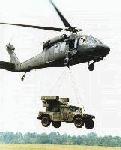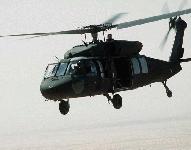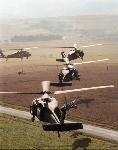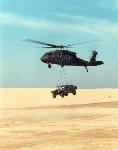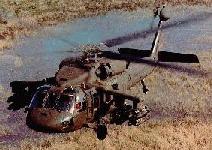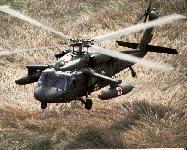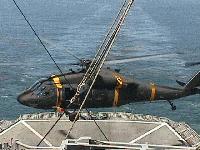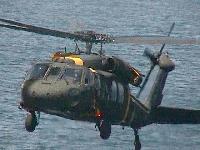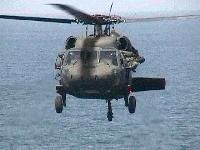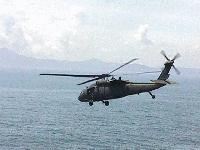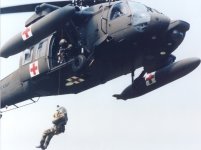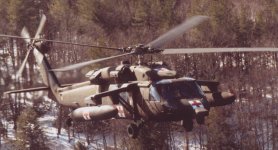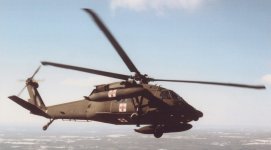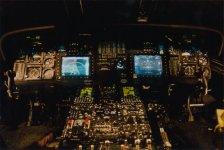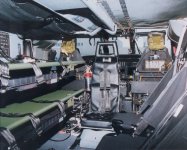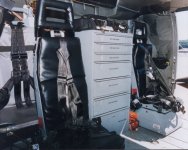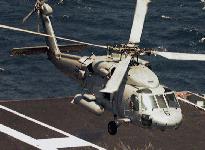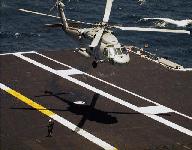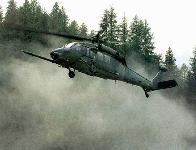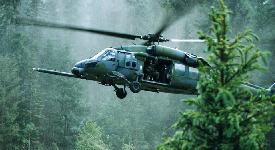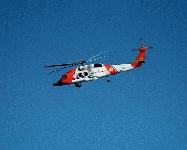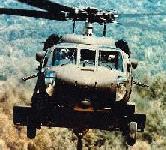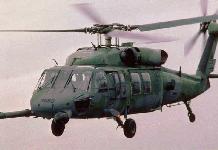



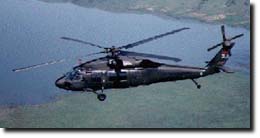
 The UH-60A, first flown in October 1974, was developed as result of the Utility Tactical Transport Aircraft System (UTTAS) program.
The UTTAS was
designed for troop transport, command and control, MedEvac, and reconnaissance, to replace the
UH-1 Series "Huey" in the combat assault role. In August 1972, the U.S. Army selected the Sikorsky
(model S-70) YUH-60A and the Boeing Vertol (model 237) YUH-61A (1974) as competitors in the
Utility Tactical Transport Aircraft System (UTTAS) program. The Boeing Vertol YUH-61A had a
four-bladed composite rotor, was powered by the same General Electric T700 engine as the Sikorsky
YUH-60A, and could carry 11 troops. In December 1976 Sikorsky won the competition to produce
the UH-60A, subsequently named the Black Hawk.
The UH-60A, first flown in October 1974, was developed as result of the Utility Tactical Transport Aircraft System (UTTAS) program.
The UTTAS was
designed for troop transport, command and control, MedEvac, and reconnaissance, to replace the
UH-1 Series "Huey" in the combat assault role. In August 1972, the U.S. Army selected the Sikorsky
(model S-70) YUH-60A and the Boeing Vertol (model 237) YUH-61A (1974) as competitors in the
Utility Tactical Transport Aircraft System (UTTAS) program. The Boeing Vertol YUH-61A had a
four-bladed composite rotor, was powered by the same General Electric T700 engine as the Sikorsky
YUH-60A, and could carry 11 troops. In December 1976 Sikorsky won the competition to produce
the UH-60A, subsequently named the Black Hawk.
The Black Hawk is the primary division-level transport helicopter, providing dramatic improvements in troop capacity and cargo lift capability compared to the UH-1 Series "Huey" it replaces. The UH-60A, with a crew of three, can lift an entire 11-man fully-equipped infantry squad in most weather conditions. It can be configured to carry four litters, by removing eight troop seats, in the MedEval role. Both the pilot and co-pilot are provided with armor-protective seats. Protective armor on the Black Hawk can withstand hits from 23mm shells. The Black Hawk has a cargo hook for external lift missions. The Black Hawk has provisions for door mounting of two M60D 7.62mm machine guns on the M144 armament subsystem, and can disperse chaff and infrared jamming flares using the M130 general purpose dispenser. The Black Hawk has a composite titanium and fiberglass four-bladed main rotor, is powered by two General Electric T700-GE-700 1622 shp turboshaft engines, and has a speed of 163 mph (142 knots).
Elements of the US Army Aviation UH-60A/l Blackhawk helicopter fleet will begin reaching their sevice life goal of 25 years in 2002. In order for the fleet to remain operationally effective through the time period 2025-2030 the aircraft will need to go through an inspection, refurbishment, and modernization process that will validate the structural integrity of the airframe, incorporate improvements in sub-systems so as to reduce maintenance requirements, and modernize the mission equipment and avionics to the levels compatible with Force XXI and Army After Next (AAN) demands. A Service Life Extension Program (SLEP) is planned for the UH-60 beginning in FY99. The UH-60 modernization program will identify material requirements to effectively address known operational deficiencies to ensure the Black Hawk is equipped and capable of meeting battlefield requirements through the 2025-2030 timeframe. Primary modernization areas for consideration are: increased lift, advanced avionics (digital communications and navigation suites), enhanced aircraft survivability equipment (ASE), increased reliability and maintainability (R & M), airframe service life extension (SLEP), and reduced operations and support (O & S) costs. Suspense date for the approved Operational Requirements Document (ORD) is December 1998.
Specifications | |
| Manufacturer | Sikorsky Aircraft |
| Performance | Max Cruise Speed |
| 4,000 ft; 95°F 152 knots | |
| 2,000 ft; 70°F 159 knots | |
| SLS 155 knots | |
| VNE 193 knots | |
| Vertical rate of Climb | 95% MRP |
| 4,000 ft; 95°F 1,550 ft per minute | |
| 2,000 ft; 70°F 2,750 ft per minute | |
| SLS > 3,000 ft per minute | |
| Service Ceiling | (ISA day) 19,1510 ft |
| Hover Ceiling MRP-OGE | |
| 95°F 7,650 ft | |
| 70°F 9,375 ft | |
| Standard Day 11,125 ft | |
| Weight | Empty 11,516 Lbs |
| Mission gross weight - 17,432 Lbs | |
| Maximum gross weight - 22,000 Lbs | |
| Maximum gross weight (ferry) - 24,500 Lbs | |
| Length | 64 ft 10 in |
| Height | 16 ft 10 in |
| Rotor | Diameter 53 ft 8 in |
| Four titanium and fiberglass blades | |
Modernizing the Medical Evacuation (MEDEVAC) system is the Army Surgeon General's number one near term priority. The General Accounting Office identified the evacuation deficiency in its report to Congress in 1992. The Army Plan states, "Enhance the battlefield medical system by acquiring modern medical evacuation aircraft" Lessons learned from Operations Just Cause and Desert Storm showed a need for medical version of the UH-60. The UH-60Q was a TRADOC FY96-10 and FY97-11 "must have" Warfighting Lens Analysis solution in order to decrease risk, improve deployability, supportability and training of the force and ensure survivability of Early Entry/Dismounted Forces. Medical Evacuation was the Surgeon General�s number one near-term medical modernization priority in the FY94-08, FY95-09, &FY96-10 Army Modernization Plan. CINC requests the replacement of UH-1 MEDEVAC aircraft with UH-60Q.
Specifications | |
| Manufacturer | Sikorsky Aircraft |
| Length | 64 feet 10 inches(rotor turning) |
| Width | 53 feet 8 inches (rotor turning) |
| Height | 16 feet 10 inches (overall) |
| Weight | 11,500 pounds |
| Propulsion | Two T700-GE-701Cs |
| Crew | Three |
| Speed | 150 knots |
| Vertical Rate of Climb | 185 FPM |
| Max Range | 315 nm (internal fuel) |

Pave Hawks are equipped with a rescue hoist with a 200-foot (60.7 meters) cable and 600-pound (270 kilograms) lift capacity. The helicopter hoist can recover survivors from a hover height of 200 feet above the ground or vertical landings can be accomplished into unprepared areas. The hoist can recover a Stokes litter patient or three people simultaneously on a forest penetrator.
The helicopter has limited self-protection provided by side window mounted M-60, M-240, or GAU-2B machine guns. Pave Hawk is equipped with two crew-served 7.62mm miniguns mounted in the cabin windows. Also, two .50 caliber machine guns can be mounted in the cabin doors. An APR-39A(V)1 radar warning receiver, ALQ-144A infrared jammer, Hover Infrared Suppression System (HIRSS), M-130 chaff dispenser, and precision navigation equipment (GPS, Inertial Navigation System (INS), Doppler) afford additional threat avoidance and protection.
Mission systems on the HH-60H make it ideally suited for operations with special warfare units. Combat-equipped personnel can be covertly inserted and/or extracted in any terrain with precise GPS navigation accuracy. A variety of insertion and extraction techniques are available, including landing, hoisting, fastrope, rappel, paradrop, McGuire or SPIE Rig, and CRRC. Additionally, Helicopter Visit Board Search and Seizure (HVBSS) operations may be conducted using one or more of these insertion/extraction techniques. HVBSS missions are designed to take control of a ship considered to be a Contact of Interest (COI). The ability to interdict or 'take down' shipping during enforcement of a naval blockade requires precise planning and execution. Tethered Duck (T-Duck) was implemented to rapidly insert troops and a Combat Rubber Raiding Craft (CRRC) to water areas. The troops fastrope down to the CRRC after it is lowered into the water, and the motor is then hoisted down to the troops to complete the procedure. Parachute operations are used for inserting troops when the helicopters are unable to land with a minumum free-fall drop altitude of 2500 feet AGL (above ground level).
The maximum speed is 193 knots with a cruise speed of 120 to 140 knots. Unrefueled range is 480 nautical miles (NM), with a combat load and aircraft at maximum gross weight of 22,000 lbs; the combat radius is approximately 200NM. Inflight refueling greatly extends this range. Pave Hawks are equipped with a retractable in-flight refueling probe and internal auxiliary fuel tanks.All HH-60G's have an automatic flight control system to stabilize the aircraft in typical flight altitudes. They also have instrumentation and engine and rotor blade anti-ice systems for all-weather operation. The HH-60G is equipped with an all-weather radar which enables the crew to avoid inclement weather. Pave Hawks are equipped with folding rotor blades and a tail stabilator for shipboard operations and to ease air transportability. The non-retractable landing gear consists of two main landing gears and a tail wheel. Aft sliding doors on each side of the troop and cargo compartment allow rapid loading and unloading. External loads can be carried on an 8,000-pound (3,600 kilograms) capacity cargo hook. The Pave Hawk can be equipped with the external stores support system.
The HH-60 is stationed throughout the world. MAJCOMS include AFRC, ANG, AFSOC, PACAF, AFMC, AETC, and ACC. ACC is the lead command. Besides a full complement of flightline support, home stations provide two and three level maintenance support functions. HH-60 helicopter is a worldwide deployable aircraft. Two 365 day a year contingencies are currently being conducted. In deployment scenarios some locations have full flightline support capabilities with limited backshop support, while other deployed sites have less support, down to a bare base scenario. A flightline support contingent is deployed with the aircraft. Depending on the deployment location and duration, varying levels of backshop maintenance support might also be deployed.
HH-60G is rapidly approaching its flying hour service life limit. Consequently, CAF will soon require either a service life extension program (SLEP) for HH-60G or procurement of a replacement aircraft for conducting CSAR operations. The HH-60G System Program Office (WR-ALC/LU) is assessing whether HH-60G�s service life limit is 8,000 flight hours, IAW the Army specification for the H-60 airframe, or actually closer to 7,000 flight hours based upon AF configuration and operating gross weights of the HH-60G. Depending on the assessment results, HH-60G aircraft (1981 models) will begin reaching their service life limit as early as FY00, if service life limit is determined to be 7,000 flight hours. Otherwise, if the limit is determined to be 8,000 flight hours, 1981 model HH-60G aircraft will begin reaching their service life limit in FY03.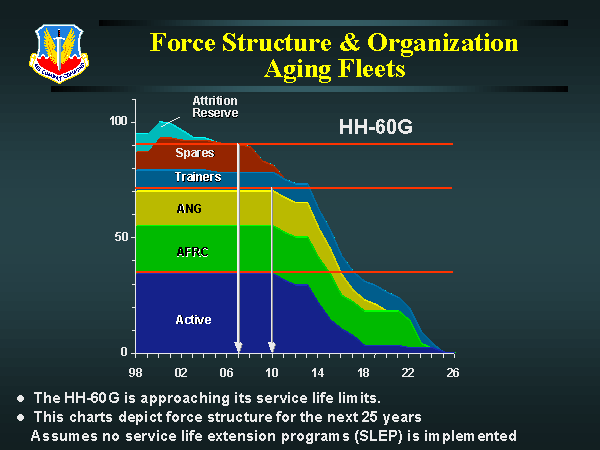
The current Fleet Combat Support Helicopter provides the Navy's Combat Logistics Force (CLF) with an at-sea Vertical Replenishment (VERTREP) capability. It also serves as the primary Search and Rescue (SAR) helicopter for the Amphibious Task Force (ATF), providing essential support to amphibious operations. The primary missions of the CH-60 will include day and night VERTREP, day and night amphibious SAR, vertical onboard delivery, and airhead operations. Secondary missions of the CH-60 will include Combat Search and Rescue (CSAR), Special Warfare Support (SWS), recovery of torpedoes, drones, unmanned aerial vehicles, and unmanned undersea vehicles, noncombatant evacuation operations, aeromedical evacuations, humanitarian assistance, executive transport, and disaster relief. The CSAR/SWS version of the CH-60 will have additional mission equipment installed that will provide the Navy with capabilities for CSAR and SWS in both the active carrier-based Helicopter Antisubmarine Squadrons (HS) and in the Reserve Helicopter Combat Support (Special) (HCS) Squadrons.
Based on the current deployment schedule, the CH-60 will first replace the H-46D helicopters in active Navy Helicopter Combat Support (HC) Squadrons. After the H-46s have been replaced, the CH-60 will replace the HH-60H helicopters in the Reserve HCS squadrons, then the UH-3H and HH-1H helicopters used as Naval Air Station SAR, range support, and executive transport missions. Finally, the CH-60 will replace the HH-60H helicopters in active Navy HS squadrons.The CH-60 configuration evolved to fill the Navy�s need for a comprehensive, rugged utility helicopter to replace the helicopters engaged in vertical replenishment (CH-46D, UH-46D and HH-46D), amphibious assault ship search and rescue (HH-46D), strike rescue and special warfare (HH-60H), station search and rescue (HH-1N and UH-3H), utility transport and target recovery (UH-3H), and VIP transport (VH-3A and UH-3H). The CH-60 will also be capable of carrying FLIR and Hellfire missiles, making it an even more versatile platform. The Navy needed a Seahawk variant but could not afford a utility version. Since the Army Black Hawk was much less expensive, the solution was to build a hybrid�a �navalized� Black Hawk that would meet the cost constraints but could be modified to operate in a ship-board environment. This takes advantage of the existing H-60 support infrastructure and reduces the number of different types of aircraft in the inventory. The Navy will save an estimated $20 billion in life-cycle costs over the life of the program.
The CH-60 will be an Army UH-60 Blackhawk utility airframe in combination with Navy SH/HH-60 transmissions and dynamic components. The CH-60 will incorporate new design items that are not in use by either the UH-60 or SH/HH-60 airframe lines. The CH-60 will adapt the Naval H-60 Tail Pylon to the Blackhawk tail cone with a CH-60 unique canted bulkhead at the tail cone, tail pylon interface. This bulkhead will �marry� the two components by providing a Naval H-60 interface on its aft face to accommodate the Naval H-60�s fold hinges and quick disconnect mechanism; and a UH-60 interface on its forward face to accommodate the UH-60�s tail landing gear and tail cone interface. The Blackhawk�s tail cone flight controls will be rerouted to accommodate the Naval H-60 rapid fold tail pylon. With a large cabin, double cargo doors and external stores support system winglets, the aircraft externally resembles a Black Hawk. Most of its Seahawk features are internal: engines, rotor brake, folding tail pylon, automatic flight control system, rescue hoist and a more durable gearbox. The production version of the aircraft will be equipped with reversible floor-boards on the cabin cargo floor, and one side will be fitted with rollers to handle up to two standard four-foot-square cargo pallets. The CH-60 will be able to operate day or night, under adverse weather conditions, including flight in light icing. The helicopter will be compatible with all current and future Aircraft Carriers, CLF, and ATF ships to include fitting inside the hangars of all CLF ships without ship alteration. The helicopter will be capable of operating over all designated ship hover areas, both day and night, and be compatible for limited operation aboard both aviation and air capable ships proportionate with a fixed fore-to-aft wheelbase of 29 feet. Sikorsky has tooled up for CH-60 production, and configuration options and a cockpit common with the SH-60R have being engineered. The first major assemblies of the CH-60 entered production late in 1998; first deliveries occured in late 1999. Reducing the types of helicopters in the fleet inventory to two airframes may enable the Navy to consolidate its HS and HC (helicopter combat support) squadrons. One possibility now being considered is for a carrier battle group to deploy with SH-60Rs and CH-60s on board the carrier, with other CH-60s detached to the battle group�s logistics ship. The CH-60 has several advantages over the HH-60H Seahawk as a strike rescue and special warfare helicopter. The Black Hawkstyle tail wheel, positioned further aft, allows for a steeper landing approach to a confined area. The CH-60�s larger cabin will enable it to carry more troops; its two larger cargo doors will allow more rapid deployment of the rigid inflatable boats for Navy sea-air-land team members (SEALs). The CH-60 also will be more crash-worthy, and will be fitted with better self-sealing fuel tanks capable of withstanding rounds up to 7.62 mm. The external stores support system installed on the CH-60 will allow more fuel and weapons to be carried.The Navy hopes that the CH-60 will be able to meet its biggest challenge�replacing the gigantic Sikorsky-built MH-53E Sea Dragon minesweeping helicopter. Although the CH-60 is too small to tow the heavy MH-53E minesweeping sleds, lightweight towed systems and laser imaging detection and ranging systems promise to make the CH-60 a capable mine hunter.
Because it is a hybrid of the Black Hawk and the Seahawk, the CH-60 presents a quandary for Sikorsky�s marketing strategy: what does one call the CH-60? A possibility being considered, partly in tribute to the H-46 Sea Knight that the CH-60 will replace, is Knighthawk. The Navy still has not assigned a type/model/series designation to the CH-60; the next letter available in the H-60 series is �S.� If used, the aircraft�s official designation would be CH-60S.
| VRML 3-D Model | |
 UH-60J VRML by Soji Yamakawa |
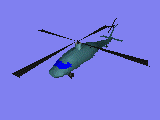 UH-60 Blackhawk VRML by Soji Yamakawa |
